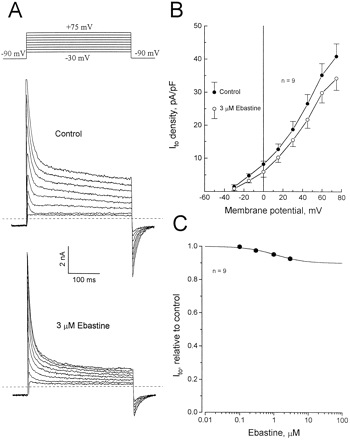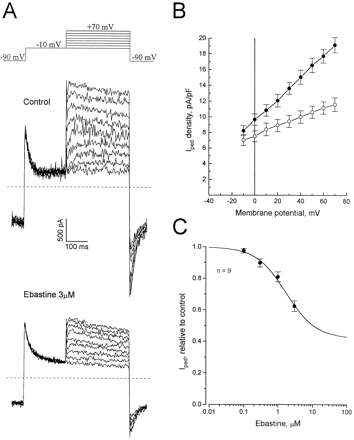
| Size | Price | Stock | Qty |
|---|---|---|---|
| 25mg |
|
||
| 50mg |
|
||
| 100mg |
|
||
| 250mg |
|
||
| 500mg |
|
||
| 1g |
|
||
| 2g |
|
||
| Other Sizes |
|
Purity: ≥98%
Epinastine HCl (WAL801CL; Alesion; Elestat; Epinastine; Epinastin; WAL-801CL), the hydrochloride salt of epinastine, is a potent antagonist of histamine H1 receptors without sedative side effects. It also functions as a mast cell stabilizer and is found in eye drops that are used to treat allergic conjunctivitis. The release of histamine from mast cells is inhibited by paroxetine, which also blocks the histamine H1 receptor. This stops histamine activity on capillaries, skin, and mucous membranes from causing the usual allergic symptoms.
| Targets |
Histamine receptor
|
||
|---|---|---|---|
| ln Vitro |
|
||
| ln Vivo |
|
||
| Animal Protocol |
|
||
| References | |||
| Additional Infomation |
Epinastine Hydrochloride is an histamine H1 receptor antagonist without sedative activity. Epinastine hydrochloride blocks the histamine H1 receptor and inhibits the release of histamine from mast cells. This prevents the typical allergic symptoms that are caused by histamine activity on capillaries, skin, mucous membranes, and on gastrointestinal and bronchial smooth muscles. Typical histamine activities include vasodilation, bronchoconstriction, increased vascular permeability, pain, itching, and spasmodic contractions of gastrointestinal smooth muscles. Epinastine also has affinity for the histamine H2, 5-HT2, and the alpha-1, alpha-2 adrenergic receptors.
See also: Epinastine (has active moiety). |
| Molecular Formula |
C16H16CLN3
|
|
|---|---|---|
| Molecular Weight |
285.77
|
|
| Exact Mass |
285.103
|
|
| Elemental Analysis |
C, 67.25; H, 5.64; Cl, 12.41; N, 14.70
|
|
| CAS # |
108929-04-0
|
|
| Related CAS # |
Epinastine; 80012-43-7
|
|
| PubChem CID |
157313
|
|
| Appearance |
White to off-white solid powder
|
|
| Density |
1.32g/cm3
|
|
| Boiling Point |
428ºC at 760 mmHg
|
|
| Melting Point |
>270ºC
|
|
| Flash Point |
212.7ºC
|
|
| Vapour Pressure |
1.56E-07mmHg at 25°C
|
|
| LogP |
3.469
|
|
| Hydrogen Bond Donor Count |
2
|
|
| Hydrogen Bond Acceptor Count |
1
|
|
| Rotatable Bond Count |
0
|
|
| Heavy Atom Count |
20
|
|
| Complexity |
378
|
|
| Defined Atom Stereocenter Count |
0
|
|
| SMILES |
Cl[H].N12C(N([H])[H])=NC([H])([H])C1([H])C1=C([H])C([H])=C([H])C([H])=C1C([H])([H])C1=C([H])C([H])=C([H])C([H])=C21
|
|
| InChi Key |
VKXSGUIOOQPGAF-UHFFFAOYSA-N
|
|
| InChi Code |
InChI=1S/C16H15N3.ClH/c17-16-18-10-15-13-7-3-1-5-11(13)9-12-6-2-4-8-14(12)19(15)16;/h1-8,15H,9-10H2,(H2,17,18);1H
|
|
| Chemical Name |
2,4-diazatetracyclo[12.4.0.02,6.07,12]octadeca-1(18),3,7,9,11,14,16-heptaen-3-amine;hydrochloride
|
|
| Synonyms |
|
|
| HS Tariff Code |
2934.99.9001
|
|
| Storage |
Powder -20°C 3 years 4°C 2 years In solvent -80°C 6 months -20°C 1 month Note: Please store this product in a sealed and protected environment, avoid exposure to moisture. |
|
| Shipping Condition |
Room temperature (This product is stable at ambient temperature for a few days during ordinary shipping and time spent in Customs)
|
| Solubility (In Vitro) |
|
|||
|---|---|---|---|---|
| Solubility (In Vivo) |
Solubility in Formulation 1: ≥ 2.08 mg/mL (7.28 mM) (saturation unknown) in 10% DMSO + 40% PEG300 + 5% Tween80 + 45% Saline (add these co-solvents sequentially from left to right, and one by one), clear solution.
For example, if 1 mL of working solution is to be prepared, you can add 100 μL of 20.8 mg/mL clear DMSO stock solution to 400 μL PEG300 and mix evenly; then add 50 μL Tween-80 to the above solution and mix evenly; then add 450 μL normal saline to adjust the volume to 1 mL. Preparation of saline: Dissolve 0.9 g of sodium chloride in 100 mL ddH₂ O to obtain a clear solution. Solubility in Formulation 2: ≥ 2.08 mg/mL (7.28 mM) (saturation unknown) in 10% DMSO + 90% (20% SBE-β-CD in Saline) (add these co-solvents sequentially from left to right, and one by one), clear solution. For example, if 1 mL of working solution is to be prepared, you can add 100 μL of 20.8 mg/mL clear DMSO stock solution to 900 μL of 20% SBE-β-CD physiological saline solution and mix evenly. Preparation of 20% SBE-β-CD in Saline (4°C,1 week): Dissolve 2 g SBE-β-CD in 10 mL saline to obtain a clear solution. View More
Solubility in Formulation 3: ≥ 2.08 mg/mL (7.28 mM) (saturation unknown) in 10% DMSO + 90% Corn Oil (add these co-solvents sequentially from left to right, and one by one), clear solution. Solubility in Formulation 4: 20 mg/mL (69.99 mM) in PBS (add these co-solvents sequentially from left to right, and one by one), clear solution; with ultrasonication. |
| Preparing Stock Solutions | 1 mg | 5 mg | 10 mg | |
| 1 mM | 3.4993 mL | 17.4966 mL | 34.9932 mL | |
| 5 mM | 0.6999 mL | 3.4993 mL | 6.9986 mL | |
| 10 mM | 0.3499 mL | 1.7497 mL | 3.4993 mL |
*Note: Please select an appropriate solvent for the preparation of stock solution based on your experiment needs. For most products, DMSO can be used for preparing stock solutions (e.g. 5 mM, 10 mM, or 20 mM concentration); some products with high aqueous solubility may be dissolved in water directly. Solubility information is available at the above Solubility Data section. Once the stock solution is prepared, aliquot it to routine usage volumes and store at -20°C or -80°C. Avoid repeated freeze and thaw cycles.
Calculation results
Working concentration: mg/mL;
Method for preparing DMSO stock solution: mg drug pre-dissolved in μL DMSO (stock solution concentration mg/mL). Please contact us first if the concentration exceeds the DMSO solubility of the batch of drug.
Method for preparing in vivo formulation::Take μL DMSO stock solution, next add μL PEG300, mix and clarify, next addμL Tween 80, mix and clarify, next add μL ddH2O,mix and clarify.
(1) Please be sure that the solution is clear before the addition of next solvent. Dissolution methods like vortex, ultrasound or warming and heat may be used to aid dissolving.
(2) Be sure to add the solvent(s) in order.
| NCT Number | Recruitment | interventions | Conditions | Sponsor/Collaborators | Start Date | Phases |
| NCT02182518 | Completed | Drug: Epinastine Drug: Placebo |
Rhinitis, Allergic, Perennial | Boehringer Ingelheim | May 2000 | Phase 3 |
| NCT02260063 | Completed | Drug: Epinastine syrup Drug: Epinastine tablets |
Healthy | Boehringer Ingelheim | November 1998 | Phase 1 |
| NCT02182531 | Completed | Drug: Epinastine Drug: Pseudoephedrine |
Healthy | Boehringer Ingelheim | August 1999 | Phase 1 |
| NCT02260037 | Completed | Drug: Epinastine nasal Drug: Placebo |
Healthy | Boehringer Ingelheim | August 2001 | Phase 1 |
| NCT01382654 | Completed | Drug: epinastine 0.1% Drug: epinastine 0.2% |
Allergic Rhinitis | Merck Sharp & Dohme LLC | September 2006 | Phase 2 |
|
|---|
 |
 |